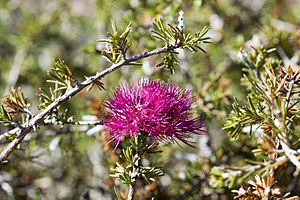Hairy-leaved beaufortia facts for kids
Quick facts for kids Hairy-leaved beaufortia |
|
|---|---|
 |
|
| Scientific classification | |
| Genus: |
Beaufortia (plant)
|
| Species: |
puberula
|
| Synonyms | |
Beaufortia puberula, commonly known as the hairy-leaved beaufortia, is a special plant. It belongs to the myrtle family, which is called Myrtaceae. This plant is found only in the south-west part of Western Australia. It grows as a shrub, usually about 2 m (7 ft) tall. You can spot it by its hairy young leaves and its pretty pink or red flowers. These flowers bloom for most of the year.
Contents
What Does Hairy-Leaved Beaufortia Look Like?
The Hairy-leaved beaufortia is a shrub. It can grow up to 2 m (7 ft) tall. Sometimes, it can spread out to be 2 m (7 ft) wide.
Leaves and Stems
Its leaves grow in pairs, one across from the other. Each leaf is small, about 1.5–4 mm (0.06–0.2 in) long. They are also about 1–1.5 mm (0.04–0.06 in) wide. The leaves are hairy, especially when they are young.
Flowers and Fruit
The flowers are pink or deep pink to red. They grow in small groups at the ends of the branches. Each flower has 5 sepals (small leaf-like parts that protect the bud). It also has 5 petals (the colorful parts of the flower).
The flowers have 5 bundles of stamens. Stamens are the parts that make pollen. These bundles are about 1–3 mm (0.04–0.1 in) long. Each bundle has 5 to 7 separate stamen filaments that are 1–2.5 mm (0.04–0.1 in) long. The inside of these bundles is smooth (called glabrous). But the outside is covered with long hairs.
This plant flowers during most months of the year. After the flowers, it grows fruit. The fruit are woody capsules. They are 10–16 mm (0.4–0.6 in) long and about 5 mm (0.2 in) wide. These capsules often grow in clusters.
How It Got Its Name
The plant Beaufortia puberula was first officially described in 1852. This was done by a scientist named Nikolai Turczaninow. His description was published in a science paper.
The second part of its scientific name, puberula, comes from a Latin word. It means "downy," which refers to the plant's soft hairs. Before this, the plant was sometimes known as Beaufortia interstans.
Where Hairy-Leaved Beaufortia Lives
Hairy-leaved beaufortia grows in sandy soil. Sometimes, it can also be found in soil with laterite (a type of red soil) or loam (a rich soil mix).
You can find this plant in Western Australia. It grows near towns like Merredin, Katanning, and Southern Cross. It is also found in several natural areas. These include the Avon Wheatbelt, Coolgardie, Geraldton Sandplains, Jarrah Forest, and Mallee regions.
Is Hairy-Leaved Beaufortia Safe?
The Western Australian Government's Department of Parks and Wildlife has looked at this plant. They have classified Beaufortia puberula as "not threatened." This means it is not currently in danger of disappearing.

